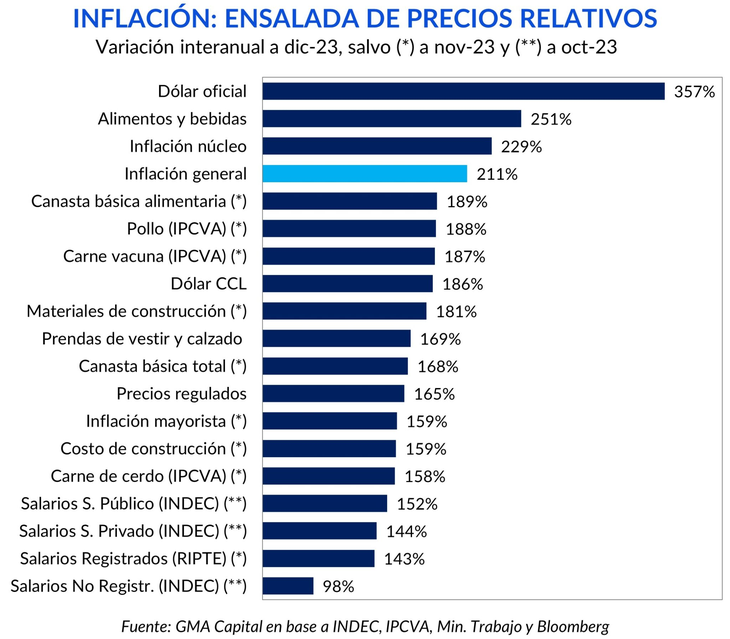The wages registered, which through parity updates tried not to lose so much to inflation throughout 2023, suffered a strong attack in December. That month there was a sharp drop in real terms due to price acceleration (the CPI rose to 25.5%) after the 54% devaluation validated at the beginning of the Government by Javier Milei.
image.png
According to a report by Ecolatina, Only the jump in inflation in December left losses in registered salaries of around 10% in real terms. This is how they explained what happened in the last part of 2023: “The acceleration of the last two months led to almost all of the unions that we follow -many of which are in the following graph- arrive in the red at the end of the year”. Before this panorama, What can we expect going forward?
There is various elements of macroeconomics which do not suggest that, in the immediate future, there will be a moderation in prices. Added to the strong devaluation of the exchange rate the correction of relative prices and the “liberation” of many other such as prepaid, fuel, telecommunications and the increase in public service rates. “This whole set guarantees several months with double-digit inflation”they specified from the same consulting firm.
In particular, they provide that Between December and March inflation averages 20% monthly. For Ecolatina, It is likely that the unions will try, in order not to have so much purchasing power, a combination of bimonthly/quarterly joint ventures but they are also expected with others with monthly adjustments -some virtually indexed-, where fixed sums will surely also proliferate to compensate for diminished purchasing power. However, they warned, “All this will not be enough, and minimum purchasing power will lose 10% of its value during the summer”.
Parity vs. inflation: who will win the battle?
For the economist Federico Glustein Nor does he believe that joint ventures will be able to compensate for inflation: “In Decemberthe real salary drop was around 13% although by 2023 the drop in general terms could be approximately 7%, considering the decline in the unregistered sector that could have reduced its purchasing power by 16/18%. By 2024, a contraction of at least 14% is expected throughout the year.prioritizing the strong adjustment of the first quarter, with possibilities of up to 20% if they do not reinforce joint ventures“.
For its part, Federico Carrera, Co-Founder & COO of High Flowalso made his analysis: “If we take into account that December inflation was 25.5% and that it is estimated that January inflation would be around 20 points, Those who do not have adjustments will soon have lost half their salary. Companies are taking measures but their speed seems to fall short of reality. At least for now, the information regarding consumption shows that there is a slowdown and that Argentines are more attentive than ever to taking care of their pockets.”
“Few have defined a monthly rhythm, some are encouraged to do it every two months, and the quarterly adjustment was already the general norm during 2023. As long as finances are good, Companies will be forced to adjust more quicklyor to accept that they will accept to let go of those to whom the market offers a better remuneration,” Carrera predicted, regarding what could happen with the joint ventures and salary adjustments in the coming months.
2023: salaries vs. other macroeconomic indicators
image.png

A report of GMA Capital maintained that “despite the discrepancy in some data, It is possible to observe a trend that hurts: salaries lost sharply last year, not only against the official exchange rate and the Cashed Dollar with Settlement, but against most of the components of the basic basket.especially Food and drinks“.
The same report detailed that, in the following months, It is expected that regulated prices will grow faster than the rest of the prices with the aim of eliminating distortions. “High frequency inflation data in the first weeks of January already validate this hypothesis,” they analyzed and projected: an inflation of 25% in January, 18.2% in February, 15% in March, 12% in April, 10% in May. The single-digit monthly variation would only return in June, with a projection of 8.3%, they closed.
Source: Ambito




